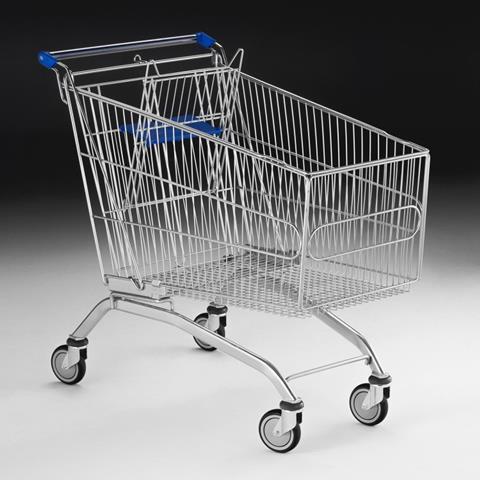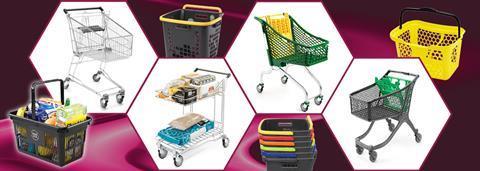First impressions are critical in grocery retail, meaning the state of trolleys and baskets set an important tone. Here we explore the impact the hardware has on customer and staff satisfaction, efficiencies and the bottom line.
In the fast-paced world of retail, where every detail counts, it’s easy to overlook the silent workhorses of the shopping experience: trolleys and baskets.
While these essential tools may not always steal the spotlight, their impact on customer satisfaction, staff efficiency, and overall store operations is undeniable, and more significant than many might ever consider.
When trolleys glide effortlessly through aisles and baskets are easy to carry, they do more than just move products; they enhance the shopping journey for customers and streamline tasks for staff, making them indispensable assets in any retail environment.
The choice of trolley, basket or neither, though seemingly mundane, is influenced by several factors that collectively set the tone for the entire shopping experience. And the availability, cleanliness and usability of these items are therefore critical.
But many retail establishments overlook this vital aspect, often offering customers trolleys with wonky wheels or mismatched, grimy baskets. These issues may seem trivial at first glance, but they carry significant implications for customer satisfaction, staff efficiency and overall business performance, long-term.

The impact on customer experience
The condition and availability of trolleys and baskets have a direct and tangible impact on the customer experience, influencing both their emotional response and practical ability to shop effectively.
Inconvenience and frustration: Imagine arriving at a store, ready to do a substantial grocery shop, only to find that all the trolleys are either in use or in a state of disrepair. The frustration of not being able to easily pick up a functional trolley can quickly lead to a negative experience. In some cases, leading them to abandon their shopping mission entirely, potentially taking their business elsewhere. This scenario highlights the immediate impact of under-investment in trolleys and baskets on customer satisfaction and, consequently, on a store’s sales.
Perception of quality: First impressions are crucial in retail. If a customer struggles to find a trolley or is left with a substandard trolley – one with a squeaky wheel, a broken handle, or simply too much dirt – it can taint their perception of the store’s overall quality. This negative first impression might cast doubts on the freshness of produce, the reliability of other products, or even the cleanliness and organisation of the store itself. Customers subconsciously associate the quality of the tools provided with the quality of the products offered.
Reduced spending: A well-functioning trolley or basket does more than just hold items; it encourages customers to explore the store more freely and, as a result, make more impulse purchases. Retailers are well aware that the more comfortable and convenient the shopping experience is, the more likely customers are to spend more time and money in the store. Conversely, if customers cannot find a suitable trolley or basket, they may limit their purchases to the bare minimum that they can carry in their hands, significantly reducing their total spend. In the long run, this can have a substantial impact on a store’s profitability.
Accessibility: Trolleys and baskets also play a vital role in ensuring accessibility for all shoppers. For customers with mobility issues, those who are elderly, or those juggling children, reliable and safe options are not just a convenience but a necessity. Without these options, retailers risk alienating a significant portion of their customer base. In a society that increasingly values inclusivity and accessibility, ensuring that all customers can shop comfortably is not just good ethics – it’s good business.

How staff efficiency is affected
While the customer experience is undeniably important, the condition and availability of trolleys and baskets also significantly affects the efficiency of store staff. Poorly managed trolley and basket systems can lead to a cascade of operational challenges.
Time-wasting: When there are not enough trolleys or baskets available, staff members often find themselves hunting for these items to meet customer demand. This task, while seemingly minor, diverts them from more critical duties, such as restocking shelves, assisting customers with product queries, or managing the checkout area. The cumulative effect of these small time-wasting tasks can be significant, leading to reduced productivity and increased labour costs.
Risk of abuse: Customer frustration over the lack of adequate trolleys and baskets can sometimes boil over into verbal abuse directed at staff members. Retail workers often bear the brunt of customer dissatisfaction, even when the issues at hand are beyond their control. Ensuring an adequate supply of these items is a simple yet effective way to improve staff well-being and reduce the likelihood of confrontational incidents in the store. A well-designed trolley and basket system can contribute to a calmer, more pleasant shopping environment for both customers and staff.
Inventory shrinkage: If customers are using a trolley that is proving difficult to manoeuvre or a basket that is uncomfortable to carry then they may abandon their shopping in an aisle. This leads to the potential for perishables to spoil, for staff to spend unnecessary time returning items they can to the shelves and for the abandoned items to be at a higher risk of shoplifting all leading to inventory shrinkage.
Noise: The constant noise from poorly maintained trolleys – squeaky wheels or rattling frames – adds to the stress for staff, who have to endure it throughout their shifts. These seemingly minor annoyances can accumulate, contributing to a more stressful and less efficient work environment.
The business case for quality investment
Given the significant impact that trolleys and baskets can have on both customer experience and staff efficiency, it’s clear that investing in quality is not just a matter of convenience – it’s a business imperative.
Value over time: Trolleys and baskets represent a significant capital investment for any retailer. Opting for the cheapest available option often results in higher long-term costs due to the need for frequent repairs or replacements. While waiting for the repairs to be done, stores are often left short of trolleys at peak times. While it may seem economical to cut corners initially, investing in durable, well-made trolleys and baskets provides better value over time. These items remain functional and attractive for years, reducing the overall cost of ownership and ensuring that customers have a consistently positive shopping experience.
Sales and loyalty: The shopping experience is about more than just the products on the shelves. If competitors offer a smoother, more convenient experience, customers may switch paths. Trolleys and baskets should be almost invisible to the shopper – tools that simply work, allowing customers to focus on finding what they need and enjoying their shopping experience. In the fiercely competitive world of retail, where customer loyalty can be hard to win and easy to lose, these small details can make a significant difference.
Maintenance and safety: Poor-quality trolleys need a lot more maintenance than a well-manufactured trolley from the best raw materials. If manufactured from a lower grade of steel, for example, then they will regularly twist out of shape making them difficult to steer and frustrating customers. These then need to be put out of use to be mended. Regular maintenance, including cleaning and repairs, can extend the life of trolleys and baskets significantly and is often necessary for insurance and to comply with health & safety risk assessments. Buyers should ensure that spare parts are easily available and that components like wheels and handles can be replaced swiftly. Neglecting this can lead to safety hazards, potential legal issues and damage to the store’s reputation. A well-maintained trolley fleet is not just about aesthetics – it’s about ensuring the safety and comfort of customers, which in turn protects the business from potential liabilities.
Congestion and flow: A shortage of trolleys or baskets can cause congestion at store entrances, slowing down the flow of customers and negatively impacting their overall shopping experience. When customers have to wait for a trolley or manoeuvre through a crowded entrance, their shopping experience starts on a negative note. This can affect their mood and, ultimately, their willingness to spend time – and money – in the store.
Perception of store quality: The condition of trolleys and baskets can also influence how customers perceive the store itself. Worn-out, shabby trolleys suggest poor management and underfunding, which can erode customer loyalty and reduce return visits. Conversely, well-maintained, easy-to-use trolleys and baskets create a positive first impression, reinforcing the store’s image as a well-run, customer-focused establishment. This positive perception can translate into increased customer loyalty and higher sales over time.
These seemingly peripheral tools of the retail experience – trolleys and baskets – have a far-reaching impact.
Investing in quality and maintenance not only enhances customer satisfaction and staff efficiency but also safeguards your business’s reputation and bottom line.
In the competitive world of retail, where every detail counts, attention to these small details can make the biggest difference. By recognising the importance of trolleys and baskets and by investing in their quality and upkeep, retailers can create a shopping environment that is not only more pleasant for customers but also more efficient and profitable for the business.










